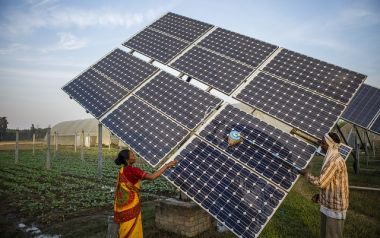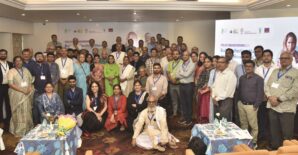- Avinash Kishore
Irrigation is one of the most effective means for boosting agricultural production, but powering the withdrawal of groundwater can be an expensive and polluting process. Solar panels provide a cleaner energy source for pumping groundwater than traditional diesel-based pumps, and their cost has rapidly fallen in recent years—exciting policymakers in South Asia about their promise as a viable and sustainable tool for rural development.
To mark Earth Day 2018 (April 22), here is a look at what our research reveals about the solar pumps and sustainable agriculture: In the Indian state of Bihar, the pumps have been an effective means for boosting wheat yields that is cheaper than diesel pumps. But appropriately implementing this technology does not come without challenges.
Encouraging the adoption of solar pumps in diverse conditions across South Asia calls for tailored approaches that leverage the benefits of the technology without creating negative impacts like market distortions or the depletion of natural resources.
Installing solar pumps has very high capital costs that most farmers in the region cannot afford. Once installed, however, solar panels provide energy for free, so that over a pump’s life-cycle, energy from a solar pump works out to be cheaper than that from a diesel pump. To address this barrier to entry, governments in South Asia are offering high capital subsidies on solar pumps.
These subsidies have been successful in increasing the use of solar pumps, but also create market distortions that limit their broader viability. If solar pumps are a viable technology, policymakers should shift their focus from subsidizing the upfront costs of buying to finding innovative ways to finance the purchases. IFPRI has worked closely with a private firm experimenting with different technological and financial innovations that hold great promise to make solar pumps an affordable purchase, even for smallholder and women farmers. But as long as heavy subsidies for solar pumps exist, such promising innovations have little chance of succeeding.
The nature of the costs of owning and maintaining solar pumps also has potentially negative impacts for the sustainable management of groundwater. Since farmers invest heavily and it costs almost nothing to maintain and use a solar-powered pump, the incentive is to pump as much water for irrigation as possible and to increase crop yields as much as possible. If solar pumps are promoted aggressively in water-scarce areas of South Asia, they can aggravate existing groundwater depletion problems.
Many state governments in India are trying to address this issue by bundling a subsidy on solar pumps with subsidized micro-irrigation systems that boost efficient water use. But this effort alone won’t suffice: Using water efficiently does not necessarily inhibit its overuse.
Instead, farmers need an incentive to save the energy produced by their solar panels for something other than pumping groundwater. Net-metering solar panels measure how much power is used out of the total produced. This technology can provide farmers the option of selling surplus electricity back to the grid—an incentive to conserve solar power, and with that, water. This approach may be the only way to make solar pumps a sustainable option in water-scarce areas.
In the Eastern Gangetic Plains of Bangladesh, India, and Nepal Teraii, governments should promote solar pumps through financial and business process innovations to make them financially viable for the greatest number of people. In the rest of South Asia, where groundwater is scarce, solar pumps should be promoted only with available net-metering. And in canal commands that regulate irrigation systems, small solar pumps connected to water storage structures can promote more efficient use of water and support high-value agriculture through better water control.
While not a panacea, solar pumps equipped with the appropriate technologies and supportive policies can help farmers across South Asia manage water more responsibly, and should be a part of any sustainable agriculture strategy.
Avinash Kishore is a Research Fellow in IFPRI's South Asia Office in New Delhi.
The blog was originally posted on IFPRI.org



